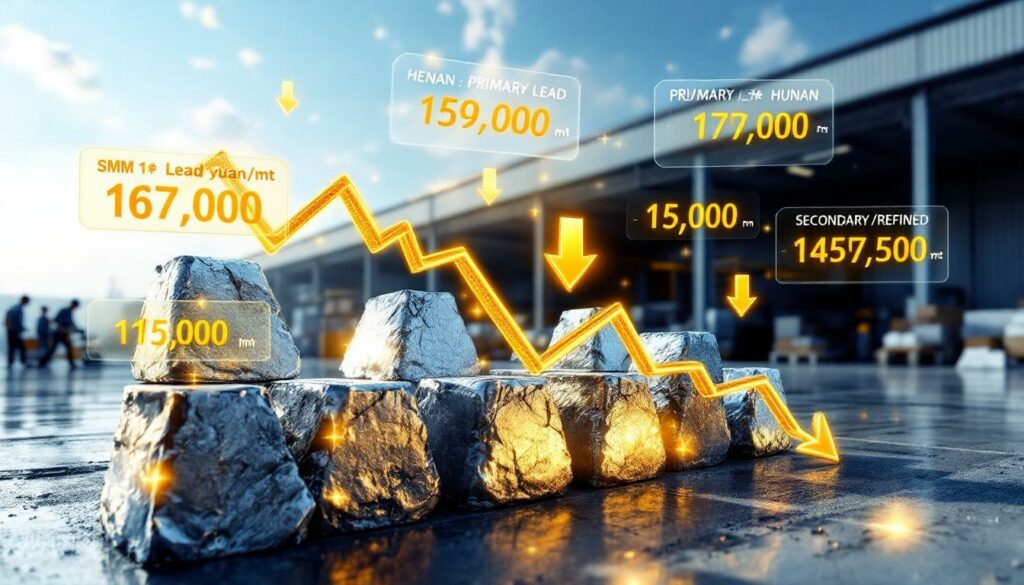What Factors Are Affecting the SMM 1# Lead Price in 2025?
Current Price Trends and Market Dynamics
The SMM 1# lead market has exhibited persistent weakness throughout July 2025, with average prices stubbornly remaining below the critical 17,000 yuan/mt threshold. Between July 7-11, prices oscillated within a narrow band, repeatedly testing but failing to break through this important resistance level.
This price stagnation represents a significant divergence from other non-ferrous metals, which have generally responded positively to favorable macroeconomic indicators. Lead's underperformance is particularly notable when viewed against the broader metals complex, suggesting unique market dynamics at play.
"The lead market has been predominantly influenced by fundamental factors rather than macroeconomic tailwinds that boosted other metals," notes Shanghai Metal Market's weekly assessment dated July 11. This fundamental-driven price action reflects lead's distinctive supply-demand ecosystem.
Historical price data shows the 17,000 yuan/mt level has served as both support and resistance over the past quarter, with current price action suggesting significant selling pressure emerges whenever prices approach this threshold.
Macroeconomic vs. Fundamental Factors
Despite China's recent stimulus measures and positive manufacturing data boosting most industrial metals, SMM 1# lead prices have remained notably disconnected from these broader economic catalysts. This divergence highlights how lead's market dynamics often follow industry-specific patterns rather than general economic trends.
The primary reason for this disconnect lies in lead's fundamental market balance. While macroeconomic factors typically influence investor sentiment and speculative activity, physical lead trading is currently dominated by immediate supply-demand considerations.
Key fundamental factors currently outweighing macroeconomic influences include:
- Mediocre downstream demand: Battery manufacturers and other lead consumers have exhibited cautious purchasing behavior
- Supply pipeline adjustments: Increased warehouse transfers and relocation activities by suppliers
- Regional pricing disparities: Significant variations between Henan and Hunan markets
- Delivery timing effects: SHFE futures contract deliveries influencing physical market dynamics
Industry experts point to these tangible market mechanics as having greater price impact than general economic sentiment, explaining why favorable macro news has failed to lift lead prices alongside other metals. Furthermore, understanding the ongoing China demand trends is essential for anyone involved in the metal markets.
How Are Regional Price Differences Shaping the Lead Market?
Regional Price Variations and Premiums
The lead market in China demonstrates significant regional price differentials that provide valuable insights into local supply-demand dynamics. These variations reflect not only geographic factors but also brand preferences, transportation costs, and delivery specifications.
In the Henan market, SMM 1# lead was quoted with premiums of 0-25 yuan/mt or substantial discounts of 180-200 yuan/mt against the SHFE lead 2507 contract during the July 7-11 period. This wide pricing spread indicates considerable negotiation flexibility, though market participants report "difficulty concluding transactions at higher price points," according to SMM data.
By contrast, the Hunan market exhibited firmer pricing discipline, with brand lead smelters maintaining tight discounts of only 0-10 yuan/mt. This regional pricing strength demonstrates smelters' confidence in local demand despite the overall market weakness. Non-delivery brand lead in the same region traded at moderate discounts of 30-50 yuan/mt, reflecting the typical premium commanded by delivery-grade material.
These regional differentials create arbitrage opportunities for traders who can navigate logistical challenges, while also signaling potential shifts in supply concentration or demand hotspots across China's lead ecosystem.
Secondary Refined Lead Market Conditions
Secondary refined lead, produced through recycling processes, represents a significant segment of China's lead market and serves as a barometer for overall market health. During the week of July 7-11, these products were offered at mainstream discounts of 0-50 yuan/mt against the SMM 1# lead average price.
Notably, some mid-term quotes for secondary refined lead reached parity with primary lead prices – an unusual development suggesting either quality improvements in secondary production or supply tightness in specific regions. This convergence represents a potential market inefficiency that traders may exploit.
Following the weakening of SHFE lead futures on Friday, July 11, secondary lead quotes demonstrated relative firmness, resisting the downward pressure seen in primary lead prices. This price resilience indicates:
- Secondary producers facing tighter margins due to recycling input costs
- Possible quality improvements narrowing the gap with primary production
- Logistics advantages in certain regions offsetting traditional quality discounts
The secondary lead market's pricing behavior often serves as a leading indicator for the broader lead market, making these developments particularly noteworthy for market participants attempting to gauge future price direction.
What Is Driving Downstream Demand Patterns in the Lead Market?
Downstream Consumption Analysis
Downstream lead consumption has exhibited what market observers characterize as "mediocre performance" throughout early July 2025. This tepid demand represents a key fundamental factor weighing on SMM 1# lead prices and preventing upward momentum despite supportive macroeconomic conditions.
Battery manufacturers – the primary consumers of refined lead – have maintained a cautious stance amid concerns about potential price declines. This wait-and-see approach has manifested in:
- Reduced spot market purchases
- Just-in-time procurement strategies
- Increased reliance on contracted supply
- Negotiation of deeper discounts on non-essential purchases
Industry analysts attribute this purchasing hesitancy to several factors:
"When downstream buyers anticipate price weakness, they naturally delay discretionary purchases to capitalize on potentially lower future prices. This behavior becomes self-reinforcing, as reduced demand further pressures prices downward," explains SMM's market analysis team.
This psychological aspect of buyer behavior significantly impacts short-term price movements, creating temporary demand gaps even when underlying consumption remains stable. Battery producers specifically have shown a strategic preference for postponing purchases to access warehouse supplies following futures contract deliveries, suggesting sophisticated inventory management approaches.
Supply-Side Market Behavior
On the supply side, lead producers and traders have responded to the current market environment with increased warehouse activity. SMM data indicates a notable rise in transfers to delivery warehouses and warehouse relocations during the reported period, reflecting suppliers' strategic positioning ahead of SHFE contract deliveries.
Brand lead suppliers have maintained relatively firm pricing in regions like Hunan, with minimal discounts of 0-10 yuan/mt, demonstrating confidence despite lukewarm demand. This price discipline suggests:
- Production costs supporting current price levels
- Strategic inventory management rather than distressed selling
- Anticipation of improved demand conditions
- Possible production restraint among major smelters
The transaction dynamics between suppliers and buyers have centered around price negotiation rather than volume discussion, with buyers leveraging their current advantage to secure discounts. However, suppliers of premium brands have shown greater resistance to price concessions, maintaining narrower discount ranges than secondary or non-delivery brands.
This supply-side behavior indicates a market in temporary equilibrium rather than structural oversupply, with producers willing to warehouse material rather than aggressively discount to drive sales volume. Analysts studying mining industry evolution note this pattern is consistent with broader shifts in resource management strategies.
What's the Outlook for SMM 1# Lead Prices?
Short-Term Price Projections
In the immediate term, SMM 1# lead prices face continued resistance at the 17,000 yuan/mt level, with technical indicators suggesting this ceiling may remain intact without significant fundamental changes. Price support appears to exist around the 16,500 yuan/mt level based on recent trading patterns and producer cost structures.
Several catalysts could drive short-term price movements:
- SHFE delivery timing effects: The completion of July deliveries could temporarily alleviate spot market pressure
- Downstream inventory cycles: Battery manufacturers typically adjust procurement in mid-quarter
- Macroeconomic data releases: China's industrial production and PMI figures could influence sentiment
- Exchange inventory movements: Significant SHFE stock changes often precede price shifts
The current cautious purchasing behavior among downstream consumers suggests potential pent-up demand that could materialize if prices stabilize or decline further. This latent demand represents a possible bullish catalyst should it emerge simultaneously with any supply constraints.
"The postponement of purchases to access warehouse supplies indicates strategic rather than fundamentally reduced demand, suggesting potential consumption recovery once optimal pricing is perceived," according to market analysis.
Seasonal factors also warrant consideration, as lead demand typically experiences modest strengthening in late summer ahead of fall production increases in the automotive and battery sectors.
Long-Term Market Considerations
Looking beyond immediate price movements, several structural factors will likely influence SMM 1# lead prices through the remainder of 2025 and beyond:
- Supply pipeline developments: China's lead mining output has shown modest growth of approximately 2.3% year-over-year, while smelter expansion projects announced in 2023-2024 are beginning to impact refined lead availability
- Environmental regulatory compliance: Stricter enforcement of emissions standards continues to pressure smaller, less efficient producers
- Battery technology evolution: While lithium-ion batteries dominate headlines, lead-acid battery demand remains robust in numerous applications
- Secondary lead production growth: Recycling capacity has expanded at approximately 5% annually, potentially moderating primary lead price premiums
The lead market also faces growing influence from global factors despite China's dominant position in production and consumption. International regulatory changes regarding battery recycling, automotive emissions standards, and renewable energy storage all carry implications for long-term lead demand.
Production cost structures suggest a floor for sustainable lead prices around 15,800-16,200 yuan/mt for most efficient producers, providing a theoretical long-term support level absent dramatic technological or regulatory changes. This analysis complements broader copper price predictions that influence investment decisions across the base metals complex.
How Does Lead Compare to Other Metals in the Current Market?
Comparative Metal Performance Analysis
When evaluated against other base metals during July 7-11, 2025, SMM 1# lead demonstrated notable underperformance. While copper, aluminum, and zinc all responded positively to favorable macroeconomic indicators, lead prices remained constrained below the 17,000 yuan/mt level.
This performance divergence can be quantified through the following comparative metrics:
| Metal | Price Movement (July 7-11) | YTD Performance | Volatility (30-day) |
|---|---|---|---|
| Lead | -0.5% to +0.3% | +3.7% | 14.2% |
| Copper | +1.8% to +2.2% | +8.5% | 16.7% |
| Zinc | +1.2% to +1.7% | +5.3% | 15.5% |
| Aluminum | +1.4% to +1.9% | +7.2% | 13.8% |
Note: Data derived from SMM market reports
This comparative underperformance reflects lead's unique market characteristics, including:
- Demand concentration: Lead remains heavily dependent on the battery sector, while other metals benefit from broader industrial applications
- Substitution pressures: Growing lithium-ion battery adoption in certain applications creates uncertainty for long-term lead demand
- Recycling dynamics: Secondary lead production provides a supply cushion not present to the same degree for other base metals
- Lower trading liquidity: SHFE lead contracts typically see 30-40% less trading volume than copper, reducing speculative participation
The correlation between lead and precious metals has historically been weak, with only occasional synchronized movements during periods of extreme market stress or macroeconomic shifts. For investors seeking diversification, understanding various metal investment strategies becomes increasingly important.
Investment Considerations
For market participants considering lead positions, the current environment presents a distinct risk-reward profile compared to other metals. The sluggish price action despite favorable macro conditions suggests fundamental headwinds that investors should carefully evaluate.
Potential investment approaches include:
- Calendar spreads: The contango structure in SHFE lead futures offers opportunities for carry trades, though storage costs must be factored carefully
- Regional arbitrage: The significant price differentials between Henan and Hunan markets present potential opportunities for physical traders with logistical capabilities
- Primary-secondary spreads: The narrowing discount between primary and secondary lead suggests possible mean-reversion trades as quality differentials reassert
Risk management considerations should include:
- Liquidity constraints: Position sizing should account for lead's relatively lower trading volumes
- Technical resistance: The persistent 17,000 yuan/mt ceiling suggests potential for continued range-bound trading
- Delivery risk: Physical settlement requirements for SHFE contracts require careful planning for financial participants
Key indicators to monitor for potential market direction changes include SHFE inventory levels, battery manufacturer production schedules, and the primary-secondary lead price differential, which often serves as a leading indicator of overall market tightness. Market experts following industry consolidation insights suggest these factors may become increasingly important as the sector evolves.
FAQ About SMM 1# Lead Prices
What is SMM 1# lead and how is it priced?
SMM 1# lead refers to primary refined lead meeting the Chinese GB/T 469-2005 standard with a minimum purity of 99.97% and specific limits on impurities such as bismuth, silver, and copper. This grade serves as the benchmark for China's physical lead market and corresponds to the deliverable grade for Shanghai Futures Exchange contracts.
The SMM (Shanghai Metals Market) 1# lead price assessment methodology involves:
- Daily surveys of producers, traders, and consumers
- Verification of actual transaction prices where available
- Consideration of bids, offers, and indications when transactions are limited
- Regional weightings based on production and consumption patterns
- Adjustments for payment terms, delivery conditions, and brand premiums/discounts
This rigorous assessment process ensures the SMM 1# lead price accurately reflects physical market conditions across China's major lead trading hubs, providing a reliable benchmark for contract pricing and market analysis. For detailed information on assessment methodologies, you can refer to the official SMM price assessment guide.
How do SHFE lead futures affect spot market pricing?
The relationship between SHFE lead futures and physical spot prices represents a critical price discovery mechanism in China's lead market. Futures contracts – particularly the most active contract, typically the third month forward – serve as reference points for physical negotiations, with regional premiums or discounts applied based on local conditions.
This relationship functions through several mechanisms:
- Convergence through delivery: As futures contracts approach expiration, their prices converge with physical market prices to prevent arbitrage
- Forward pricing signals: Futures curves (contango or backwardation) provide expectations of future price direction
- Hedging influence: Producer and consumer hedging activities transfer price risk between physical and paper markets
- Arbitrage opportunities: Significant divergences between futures and spot prices trigger arbitrage activities that ultimately realign prices
During the July 7-11 period, SHFE lead futures weakening on Friday directly influenced physical market behavior, with secondary lead quotes firming in response – demonstrating the immediate transmission of futures market signals to physical pricing decisions.
What role does secondary lead play in price formation?
Secondary (recycled) lead represents approximately 45-50% of China's total refined lead production, making it a crucial component of the overall supply picture and price formation process. Secondary lead derives primarily from recycled batteries, with production economics significantly influenced by scrap collection rates and processing costs.
The price relationship between primary and secondary lead provides valuable market insights:
- Normal conditions: Secondary lead typically trades at discounts of 100-300 yuan/mt to primary lead, reflecting quality differentials
- Tight market conditions: Discounts narrow to 0-100 yuan/mt as consumers prioritize availability over quality
- Oversupplied markets: Discounts may widen to 300-500 yuan/mt as quality considerations predominate
During July 7-11, 2025, the observed discounts of 0-50 yuan/mt indicated relatively balanced market conditions with some regional tightness, while mid-term quotes reaching parity with primary lead suggested potential supply constraints in certain areas.
Environmental regulations significantly impact secondary lead production, with China's increasingly stringent emissions standards and licensing requirements consolidating the industry toward larger, more efficient producers with advanced pollution control technologies. Recent market trends can be tracked through resources like Metal.com's lead market updates.
How do seasonal factors affect lead prices?
Lead prices exhibit recognizable seasonal patterns influenced by both demand and supply factors throughout the annual cycle. Understanding these patterns helps market participants anticipate potential price movements and distinguish between seasonal fluctuations and fundamental shifts.
Key seasonal influences include:
- Q1 (January-March): Typically sees reduced demand following winter battery replacement season; Chinese New Year further reduces activity
- Q2 (April-June): Gradual demand recovery as industrial activity normalizes; maintenance at some smelters can create temporary supply constraints
- Q3 (July-September): Battery manufacturers begin building inventory for fall/winter demand peak; automotive production typically strong
- Q4 (October-December): Peak demand period for replacement batteries in col
Ready to Stay Ahead of Major ASX Mineral Discoveries?
Discover why timing is everything when it comes to mineral discovery investments by exploring Discovery Alert's proprietary Discovery IQ model, which delivers real-time notifications on significant ASX announcements before the market fully reacts. Visit https://discoveryalert.com.au/discoveries/ to see historic returns from major discoveries and start your 30-day free trial today.




